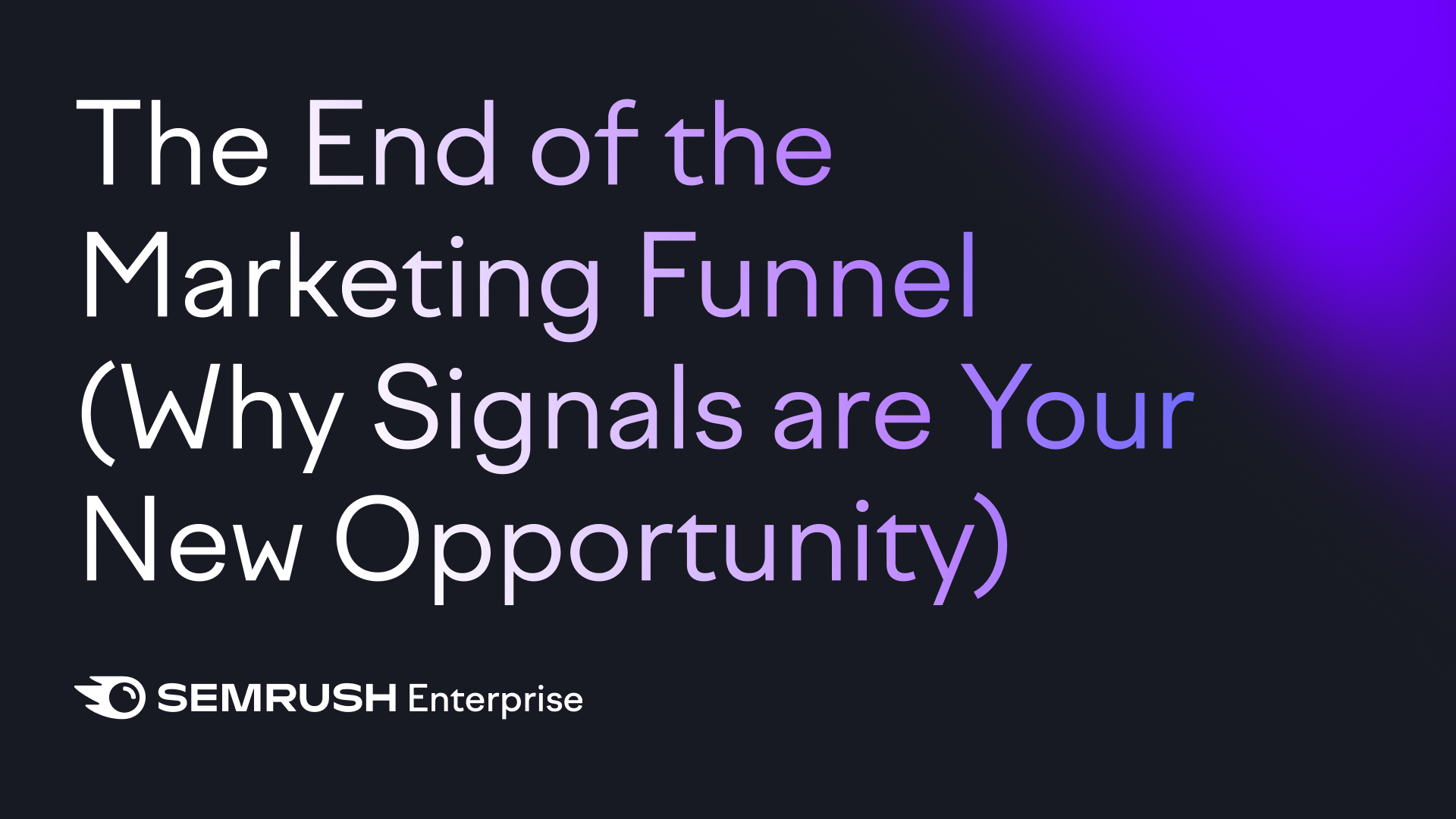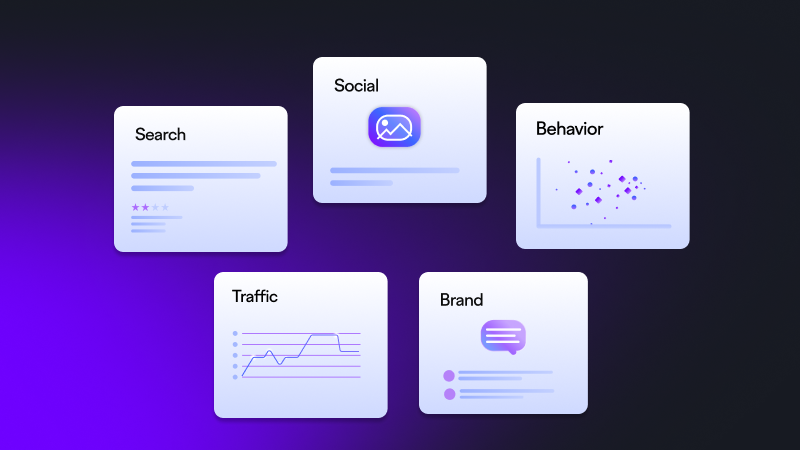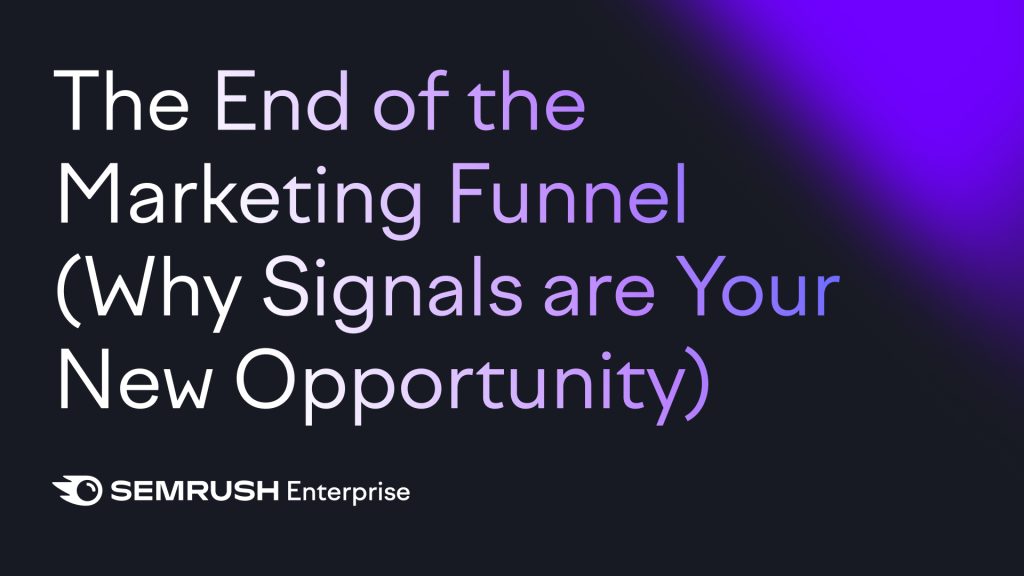The end of the marketing funnel: Why signals are your new opportunity by Semrush Enterprise


Today’s customer journeys look less like funnels and more like works from Jackson Pollock; splashes of touchpoints across dozens of channels.
Digital transformation has “fractured consumer journeys into unpredictable, nonlinear patterns,” per Boston Consulting Group’s research, and AI is accelerating this complexity at breakneck speed.
Here’s the take: The real opportunity isn’t in controlling the journey. It’s about consistently and authentically showing up where your customers already are.
Customers don’t move in order – they move everywhere

The traditional marketing funnel assumes customers move predictably from awareness to consideration to purchase. It’s an assumption that makes presentations cleaner and attribution models simpler. But it’s also completely removed from reality.
MarTech’s analysis reveals that 73% of retail shoppers now use multiple channels throughout their journey. Not sequentially. Simultaneously.
Customers are researching on TikTok while traveling to your competitor’s store, checking G2 reviews while your salesperson is mid-pitch, and asking ChatGPT for recommendations while your landing page loads.
This behavior taps into a principle called “cognitive offloading.” When faced with complex or stepped decisions, we can fragment our research across multiple sources to minimize the load. Your customers aren’t being difficult; they’re being human.
The outcome? Increasingly diverse touchpoints for discovery and research.
Social media is becoming search
The lines between channels are increasingly blurring. Social media, traditionally a brand channel, is increasingly vital to search.
46% of Gen Z and 35% of Millennials now prefer searching on social media. This is an important deviation from search engines as social search is push-based.
Algorithms surface relevant content before users even know they need it. It’s the difference between going to the library with a specific book in mind versus walking into a store and discovering a book you didn’t know existed.
The psychological principle at play here is “peripheral route processing.” When we’re in a browsing state (like scrolling TikTok), we’re more influenced by peripheral cues like social proof, aesthetics, and emotional appeal rather than systematic evaluation of facts.
Alongside this behavior is the fact that social media channels like LinkedIn or YouTube fuel and shape the AI search visibility of brands.
These reasons together explain why a 15-second TikTok can drive more purchase decisions than a 3,000-word research study. And why we need to rethink our siloed approach to channels.
Every touchpoint builds – or breaks – trust
The average customer might encounter your brand through a Reddit comment, a TikTok video, an AI chatbot response, and a retargeted ad all in one day.
MarTech’s research describes modern channels as “layered” rather than linear. Every layer simultaneously offers an opportunity to deepen connection and a risk of losing it entirely.
The difference between success and failure is ruthless consistency.
This isn’t about having the same logo everywhere (though that helps). It’s about ensuring that whether a customer encounters you through a ChatGPT response or an X thread, the core message, values, and facts remain constant.
Consistency builds trust – and trust is the only currency that matters when you can’t control the conversation.
Consider how Apple maintains consistency across thousands of touchpoints. Whether you’re in an Apple Store, watching an iPhone review on YouTube, or asking Siri about features, the message is remarkably consistent: simplicity, premium quality, seamless integration.
They don’t control every conversation about their products, but they’ve made their narrative so consistent that it’s hard to misrepresent.
5 core signals that decode real customer behavior
While everyone else is trying to patch their broken funnel back together, the smartest brands are abandoning it entirely. They’re replacing linear thinking with something radically different: a unified signal system that treats every customer interaction as intelligence, not just another touchpoint to optimize.
The framework is deceptively simple. Instead of forcing teams to think in stages, you organize around five core signals that actually reflect how customers behave in 2025:
- Search signals tell you what customers want before they know your brand exists. This isn’t just SEO data, it’s AI search queries, voice assistant requests, and the questions people ask their favored platform at 2 a.m., whether it happens on Google, Perplexity, or TikTok.
- Traffic signals reveal how people actually move through digital spaces. Forget last-click attribution. This is about understanding the full journey – including the 70% of touches that happen on platforms you don’t control. It’s knowing that a Reddit thread can drive as much qualified traffic as your PPC campaign.
- Behavior signals show what people do, not what they say. Cart abandonment is a behavior signal. So is spending 12 minutes on your pricing page before moving directly to a competitor. Traditional analytics miss most meaningful behaviors because they only measure what happens on your domain.
- Social signals capture the conversations you’re not part of. Every subtweet, every LinkedIn comment, every Discord discussion about your category is data. As Google executive Prabhakar Raghavan put it: “40% of young people, when they’re looking for a place for lunch, they don’t go to Google Maps or Search.” Yet many companies treat social listening as a vanity metric exercise.
- Brand signals measure perception velocity, or how quickly sentiment shifts, spreads, and sticks. This includes everything from branded search volume to the tone of AI-generated summaries about your company. When ChatGPT describes your competitor as “innovative” but calls you “established,” that’s a brand signal that influences future market share.
Why this shift matters
Funnel-based thinking creates organizational blindness:
- Your SEO team optimizes for search without knowing what your social team sees.
- Your brand team launches campaigns without understanding behavior patterns.
- Everyone’s optimizing their slice while the whole pie shrinks.
Signal-based organizations see more.
When search signals show rising interest in a competitor’s feature, traffic signals confirm people are researching alternatives, behavior signals reveal they’re comparing prices, social signals indicate frustration with your product, and brand signals show sentiment declining – you don’t need six meetings to figure out you have a problem. The signals tell a unified story that demands immediate action.
The operational impact is profound, directly addressing what Adweek’s 2025 CMO Summit identified as marketing’s top pain point: “managing fragmented customer experiences.”
From chaos to clarity: Your action plan
Ready to rise above the chaos? Here’s your action plan:
- Audit your AI presence: Search for your brand on ChatGPT, Perplexity, and other AI tools. What comes up? What citations are being used? Spend an hour this week understanding how AI currently represents you.
- Create platform-native content: Stop repurposing. Your TikTok strategy shouldn’t be your Instagram strategy with different dimensions. Each platform has unique discovery mechanisms, audience expectations, and content formats. Respect them.
- Build a single source of truth: Create a comprehensive, structured content hub that serves as the definitive source for all product information, FAQs, and brand messaging. This isn’t just for customers. It’s for your own teams and the AI systems that inform customers.
- Implement cross-channel analytics: Traditional attribution is over. You need tools that can track influence across fragmented touchpoints. Look into unified marketing intelligence platforms, like Semrush Enterprise that can connect signals across search, traffic, behavior, social, and brand.
- Target strategic gaps: Your social media manager needs to have visibility of SEO. Your SEO team needs to understand AI optimization. Your content team needs to be a part of all of it. Break down the silos before they break you.
The promise is straightforward:
- Fewer silos because everyone’s watching the same signals.
- Clearer actions because signals tell stories, not just statistics.
- Faster answers because you’re not waiting for monthly reports.
- Earlier risk detection because signals shift before sales do.
The future (and need for signal-based thinking) is here
The funnel assumes customers move in one direction. Signals recognize that customers move in every direction simultaneously.
The brands that will thrive will embrace leveraging each touchpoint with purpose – they won’t just have eye-catching social media feeds or top search rankings.
The strategic imperative is now to consistently appear where customers are, in whatever form they prefer, with messages that resonate in that medium.







Recent Comments